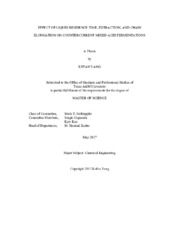| dc.description.abstract | The carboxylate platform is one of three recognized processes (sugar, thermochemical, and carboxylate) that converts biomass into chemicals and hydrocarbon fuels. One example of the carboxylate platform is the MixAlco process. Using mixed-culture countercurrent fermentation, biomass is digested into carboxylate salts. Using chemical reactions (e.g., hydrogenation), a variety of products are produced such as alcohols, esters, ketones, and ethers. In this process, methane production is blocked using an inhibitor, which enhances product value. To enhance the conversion of biomass and increase product yields, the following experiments were done.
To extend the liquid residence time, the liquid maintenance target was adjusted to increase the total liquid volume of the system. The average liquid residence time was 88.9 days compared with the traditional 20–30 days. The results show that the concentration of liquid product is 34.3 g/L, conversion is 64.2%, yield is 11.2%, acetic acid equivalent yield (aceq) is 16.6%, selectivity is 17.5%, and acetic acid equivalent selectivity is 25.9%. Also, this countercurrent system shown comparably high selectivity to butyric acid.
Using the established steady-state countercurrent fermentation system described above, all the conditions are the same except for the usage of resin extraction. The average concentration of liquid product is 28.4 g/L which is lower because of the extraction. The conversion is 70.3%, total acid yield (including resin extraction) is 16.5%, aceq total acid yield is 27.0%, selectivity is 23.4%, and aceq selectivity is 38.5%. The conversion, yield, and selectivity all were enhanced. The extraction enhances the selectivity of liquid product, especially the selectivity of medium-chain carboxylic acids (C5–C7), which means extraction using a resin promotes chain elongation in the secondary fermentation. One explanation is that extraction reduces product inhibition.
Introducing ethanol to a countercurrent fermentation system shows different phenomenon compared with a previously investigated batch system. In countercurrent fermentation, primary fermentation was promoted, but chain-elongation was inhibited. In contrast, batch fermentation enhanced chain-elongation. | en |


